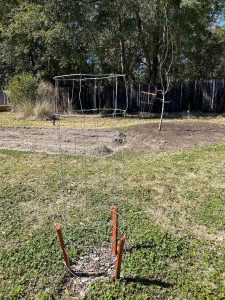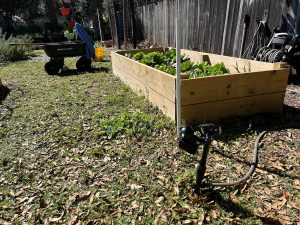Attracting wildlife is one of the Florida Friendly Landscaping principles. However, some species are better observed from long distance. Deer are beautiful creatures and taste pretty good too, but they can wreak havoc to a landscape and to fruits and vegetables. There are a number of methods to deter deer, but you’ll need to keep them guessing to limit damage to your yard.

A plant cage formed from metal fencing. Photo Credit: Matt Lollar, UF/IFAS Extension – Santa Rosa County
Physical Barriers – This deterrent method may be the most effective if installed correctly, but it can also be costly and requires the most labor and engineering to install.
- Temporary Deer Fencing – Plastic mesh fencing can temporarily keep deer away from plantings. This material can be draped over plants or attached to posts or fencing with plastic ties or wire.
- Hardware Cloth and Seedling Tubing – Hardware cloth can be formed into different shapes or secured to small structures to form a barrier around small plants. UV-inhibited polyethylene and polypropylene mesh seedling tubes can be bent into cylinders and placed around young shrubs and trees to protect them from foraging deer and other wildlife.
- Garden Fencing – There are a variety of gauges available for this fencing. Heavier gauges are recommended to help keep deer out. It’s important to note that most adult deer can jump 7 feet high, so a fence height of at least 8 feet is recommended.
- Electric Fencing – Peanut butter can be spread on a single strand of electric wire to encourage deer to check it out. More permanent electric fences can be installed, but are significantly more expensive.
Scare Items – Deer are skittish to things that are unfamiliar to them. However, it doesn’t take them long to adapt.
- Ribbons and Tape – Light-weight ribbons and tape fluttering in the wind can help deter deer. Holographic and iridescent foil materials have shown the best results because they reflect sunlight and create more noise in the wind.
- Motion Activated Sprinklers – Hitting a deer directly and the sound of water being turned on are deterrents for deer and other wildlife. It is best to periodically move the location of these sprinklers to improve their effectiveness.
- Noisemakers – Whistles, firecrackers, and propane cannons can annoy deer, and people too. Unfortunately, deer become accustomed to these tactics. It is best to use noisemakers in combination with other deterrent methods.
- Dogs – Just having a dog around can help keep deer away. Even if it’s a dog that has no care to bark at or chase a deer, its scent alone may be enough to deter them.

A motion activated sprinkler used to deter wildlife from a raised bed garden. Photo Credit: Matt Lollar, UF/IFAS Extension – Santa Rosa County
Chemical Repellents – A plethora of chemicals are marketed as deer deterrents. These products can work as odors, create bad tastes, or incite fear. Common ingredients include capsaicin, predator urine, egg solids, garlic, and soap. A number of factors can contribute to the effectiveness of chemical repellents including the growth stage of the plants to be protected and frequency of reapplication,
Resistant Plants – Deer eat almost anything. They sometimes even eat so-called “deer resistant plants”. However, the plants listed below are less desirable to deer. For a more comprehensive list of plant susceptibility to deer damage please visit the archived publication “Ornamental plant susceptibility to damage by deer in Florida”.
- Trees – Deer will rub on almost any tree, but a few they are less likely to eat include: bottlebrush, sabal palm, crape myrtle, edible fig, loquat, live oak, magnolia, and yaupon holly.
- Shrubs – Some shrubs that deer are less likely to eat include: mahonia, viburnum, wax myrtle, juniper, and most evergreen azaleas.
- Annuals and Perennials – There are quite a few annuals and perennials that have shown signs of resistance to deer including: black-eyed Susan, bush daisy, cone flower, dusty miller, marigold, and salvia.
More detailed information on wildlife deterrents can be found in the publication “How to Use Deterrents to Stop Damage Caused by Nuisance Wildlife in Your Yard”.
- Gardening in the Panhandle LIVE! Program Summary: Pests of Florida Lawns and Landscape Plants - May 28, 2025
- Fun Facts About Ferns - April 30, 2025
- Gardening in the Panhandle LIVE! Program Summary: Freeze Friendly Foliage Plants - April 30, 2025
